In This Chapter
9.2 Different Approaches to Mastering
9.9 Dithering, Bouncing, and Burning
Knowledgebases
Plug-In Focus
Multipressor and Multiband Compression
Walkthroughs
Editing and Assembling a CD in knowledgebases WaveBurner
Audio Mastering and CD Burning
Mastering in Logic
If you’ve ever tried burning a few tracks onto a CD, you’ll be well aware of the challenges of producing a CD that sounds comparable to a commercial release. Even with a complete mastery of the production process, and some great-sounding final mixes, your CD could still sound weak and, comparatively, amateurish. Although OSX and iTunes offer integral CD creation and burning, the fact is that professional musicians and bands will invest a significant amount of money and experience in turning their finished mixes into a final product. So does this mean that users of Logic can’t enjoy the same degree of finesse and polish? Well, with a little know-how, and the audio tools of Logic, you too can produce a release-quality CD master.
The term mastering describes the process of compiling and editing several (possibly contrasting) recordings, applying some form of audio “sweetening,” and assembling these to produce a final Red Book “production master” CD. Traditionally, mastering has necessitated the use of a separate facility (other than the music studio), specially equipped with mastering equipment including multiband compressors and high-end mastering EQ, as well as dedicated workstations like Sonic Solutions, Pyramix, or Sequoia. Nowadays, however, the world of media is a lot more demanding, so it’s not uncommon for musicians, bands, and composers to master by themselves. The bar, it appears, has been raised – but Logic is certainly up for the challenge!
9.2 Different Approaches to Mastering
Mastering itself can be divided into several objectives. First, of course, is the sweetening we most commonly associate with a commercial CD – in other words, the use of compression, EQ, and a host of other processes across the finished two-track master. Second, tracks will also need to be edited – setting correct start and end points for example, or placing any fade-ins or fade-outs as required. Finally, the finished files or regions need to be ordered for the CD, with appropriate markers to define the tracks and index points that appear on the CD. With these three objectives, you can master in the Logic universe.
The first technique, and the one most Logic Express users are used to, is the idea of applying mix sweetening, edits, fade-outs, and dithering all options inside the main Logic application. The finished files are then rendered (using Bounce to Disk) or exported as 16-bit 44.1 kHz files ready for compilation. The compilation process, however, requires the use of other software – either iTunes (Apple’s integral audio-CD burning tool) or dedicated Red Book software like Jam.
For the quickest and the most integral solution to the mastering problem, you can burn CDs directly from Logic. Again, sweetening and edits can be applied directly to the main application. The burning of CDs, however, is carried out from the Bounce menu – rather than rendering an audio file, you’ll burn the finished mix onto a CD. This method is, arguably, the quickest way of creating a CD, especially with just one or two tracks needing to be burned, but it doesn’t offer the most flexible solution in the long run.
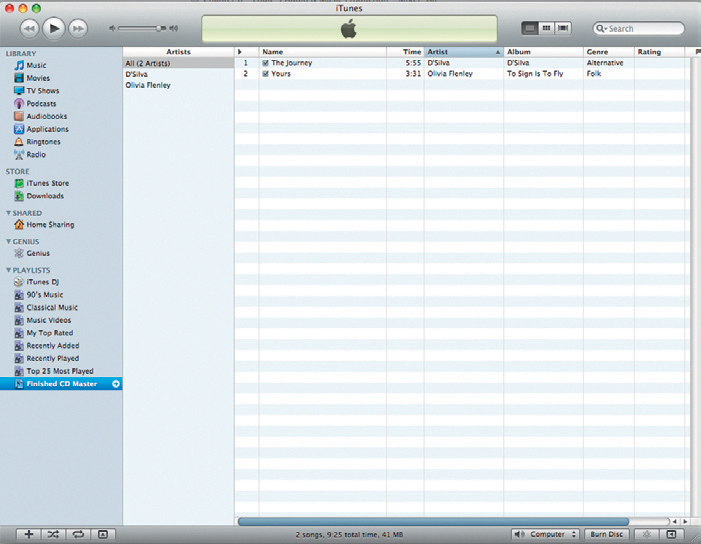
Figure 9.1 Audio Masters, exported from Logic, can be assembled into a finished CD using iTunes or any other suitable Red Book standard software.
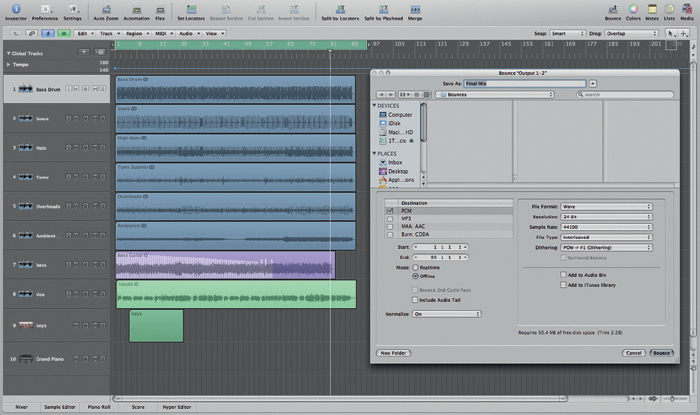
Figure 9.2 For a quick CD, use Logic’s integral CD Burn feature, as part of the Bounce to Disk option. Although this method is an easy way of burning single tracks (a rough mix, for example), it can be too restrictive for professional mastering.
The best technique – although only available to users of Logic Studio – is to use Apple’s dedicated Red Book application called WaveBurner. Originally developed by Emagic, WaveBurner has previously been sold as an individual program, but is now included as a standard in Logic Studio. In essence, WaveBurner shares many features with Logic (including plug-ins like Multipressor or Denoiser) alongside tools specifically dedicated to the process of assembling a Red Book standard CD. The real advantage, however, is the way in which you can experiment with the order and sound of your CD – with automatic track crossfades, individual plug-ins for each region (or track), and the important Red Book options like International Standard Recording Codes (ISRC) and CD-Text.
Whether you are mastering in Logic itself, or using another application (like WaveBurner), the first step will be to render your Logic mix as an audio file. The temptation to apply audio sweetening or fades in the main Logic project can be persuasive, but this should be avoided at all costs. Ideally, if you have at least one copy of your song unmastered at 24 bits, then it would be more suitable to take to a professional mastering engineer (when the lucrative record deal arrives!) than a home-mastered, 16-bit file. Separate high-resolution files also afford you the opportunity to approach mastering your work away from the “headspace” of a mix, so that tracks sound correct in terms of the whole CD rather than on an individual basis.
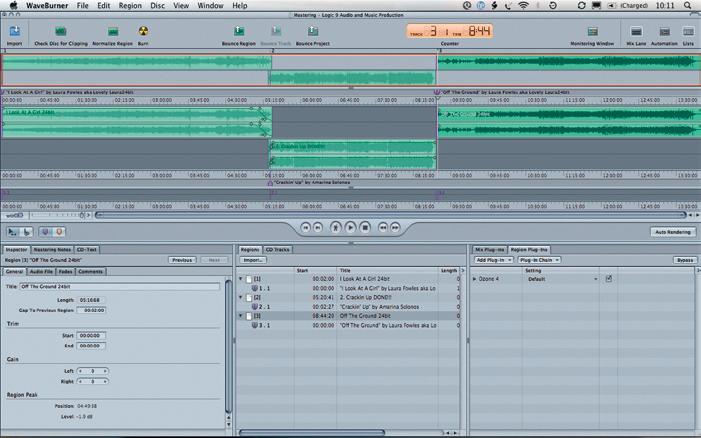
Figure 9.3 WaveBurner offers the best method for mastering Red Book compliant CDs.
The Bounce dialog window can be accessed through the Bounce button, on the main output channel strip. Before clicking on this, you’ll need to define the length of the bounce, designated by the current cycle length – without this, Logic will simply default to bouncing from the beginning of the first region to the end of the last. By defining the length manually, you can keep the best account of a few crucial factors – namely, the “hangover” at the end of the track generated by reverb tails and the allowance of a small amount of silence at the start of the audio file. At this stage, it’s probably best to render a slightly larger file, rather than too small, as trying to add information later (say, for example, when a reverb tail gets cut off) can be tricky, if not impossible.
Knowledgebase 1 ![]()
Officially, the term “mastering” refers to the process of cutting a master disc from which the records would be pressed in duplication. Pre-Mastering originally described the process that engineers used to prepare the audio signal for the vinyl medium. Nowadays, the term mastering tends to be used in place of Pre-Mastering and describes the process of preparing the audio for the intended medium, ordering the music and also signal processing.
In the Bounce window, you’ll need to specify the file type, resolution, and dithering options. Ideally, a PCM, AIFF, 24 bit, 44.1 kHz, interleaved file is considered the best “raw data” for mastering. More important, you should check that the dithering has been set to none, as dithering is best applied at the very last stage of mastering when the word length is reduced to a 16-bit master. The bounce itself can be carried out in Realtime (maybe you’ve got some live synths or effects coming into the audio mixer) or Offline – a quicker way of rendering to file by temporarily devoting all your computer’s resources to the bounce process.
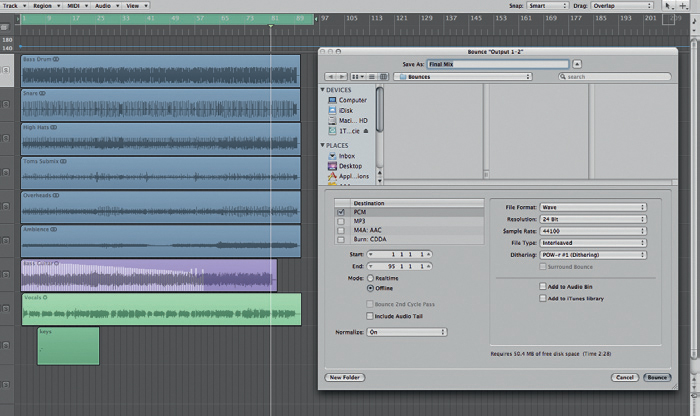
Figure 9.4 When performing a bounce in your Logic arrangement, check that the duration of the bounce is slightly longer than your track and the resolution is 24 bit.
Knowledgebase 2 ![]()
Dithering is an essential part of the analog-to-digital conversion process. However, the process of dithering a signal also refers to the process of altering the word length to suit your specification. For example, if you bounce your Logic song as a 24-bit file but wish to place this on a Red Book CD, you will need to dither this down to 16 bits. The 24-bit recording will allow for a much more accurate 16-bit file because of the increased resolution, unlike the “dither” noise added in 16-bit A/D conversion. Logic employs a licensed algorithm called Psychoacoustically Optimized Wordlength Reduction (POW-r) from the POW-r Consortium LLC (http://www.mil-media.com/docs/articles/powr.shtml). The POW-r algorithm is considered one of the best dithering algorithms and is widely supported by mastering engineers around the world.
With the raw data of your tracks assembled, you can begin to look at mix sweetening. Whether you’re using WaveBurner or Logic, the principal plug-ins and objectives will be the same, although the exact details of their application will vary. With the various songs pulled into a master Logic session, you could place each region on a different track and experiment with various plug-ins to reach the desired sound. Ideally, the CD should present a rounded and uniform tone throughout, with a consistent “loudness” across the tracks – you could even try importing some commercial tracks as a reference to see just how far you can take things. Exactly how you achieve this will vary from track to track.
The principal tools used in mastering are well represented in Logic, with a number of dedicated mastering plug-ins, including phase-linear EQ, multiband compression, and limiting. Obviously, you can use any plug-in where appropriate, but these particular tools will be the most useful in achieving a professional sound. Plug-ins can be inserted either on the individual track’s insert points (for song-specific processing) or across the main master-channel strip for general application (maybe when the album needs to be limited as a whole, for example). As with any audio processing, the order of the plug-ins is vital for the end result, although the widely accepted order for mastering is EQ, followed by compression, and finally limiting. Metering (applied across the main output using the Channel EQ’s Spectrum Analyzer or the Multimeter plug-in) will help keep an overview of things – note, in particular, how the commercial tracks might meter differently to your own mixes.
Besides preparing the sound of the tracks, it’s also important to look at some other important mastering details, like the exact start and end points, and any desired fade-ins or fade-outs. Having already mastered audio editing in Chapter 5, you should have no problems switching over to working on whole songs rather than individual regions. When you’re editing the start point, however, make sure you leave a small amount of silence and don’t cut right to the beat – this allows for older CD players to demute and stop the track from “jumping-out” at the start of playback. Also, pay close attention to unwanted noise at either end of the track – the easiest way to address this is to either use the Sample Editor’s Functions menu to “Silence” unwanted noise, or use a quick Fade In and Fade Out as appropriate.
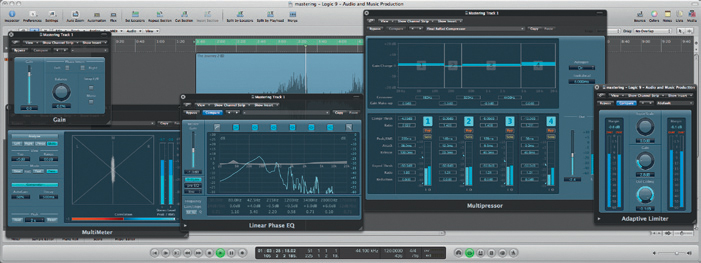
Figure 9.5 Mastering in Logic using a combination of channel inserts and the main stereo output’s insert points.

Figure 9.6 Use Logic’s Sample Editor to perform basic “top and tailing” tasks, like silencing unwanted noise or creating small fades (as illustrated).
Creating proper track fade-outs (i.e., fading out over the last chorus) is a little more taxing. The problem lies in the fact that adding a fade using Logic’s conventional method – arrangement area fade tool – doesn’t account for the use of mastering processors. As the fades are preeffects, any corresponding change in the level of the track will result in a change in compression – so as the track fades out, for example, it slowly loosens its compression. To counteract this, try performing another bounce, this time with the processing in place. The new “compressed” region can then be reinserted into Logic (the old effect being disabled), and then, the fade can be applied.
Plug-In Focus 1 ![]()
Having looked at Logic’s standard channel EQ in the mixing chapter, let’s take a look at the mastering-orientated Linear-Phase EQ. Being much more CPU intensive than the Channel EQ, the Linear-Phase EQ produces a technically superior sound by removing the phase shifts (caused as frequencies are cut and boosted) that occur in a conventional EQ. Even with its CPU drain, the Linear-Phase EQ is a welcome and sonically accurate tool for enhancing and shaping the timbre of a track in mastering. Operationally speaking, the Linear-Phase EQ includes the same controls as found on the Channel EQ, and the same phenomenally useful FFT analyzer.
Applying EQ in mastering requires an approach different to that of mixing. On the whole, your approach needs to be as subtle as possible – remember everything you do will be much more noticeable as you’re only working with two stereo tracks! Try to keep boosts, or preferably cuts, to a maximum of +/–3 dB with a wide bandwidth (low Q parameter) – if you’re going beyond this, you may well have a problem with the original mix. Overall, your track should exhibit a smooth response, with a gentle roll-off of high frequency energy. Remember though that there are other tools that can also have a timbral effect on the mix – sometimes more successful than EQ – like multiband compression (especially on bass) or harmonic excitement (for some top-end sparkle).
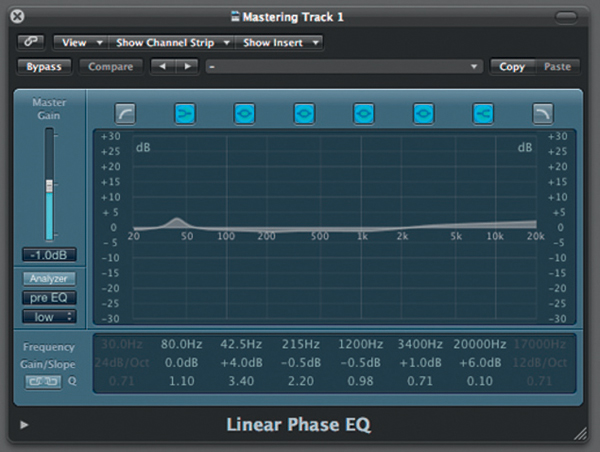
Figure 9.7 The Linear-Phase EQ removes any of the usual phase shifts that occur with conventional parametric equalization.
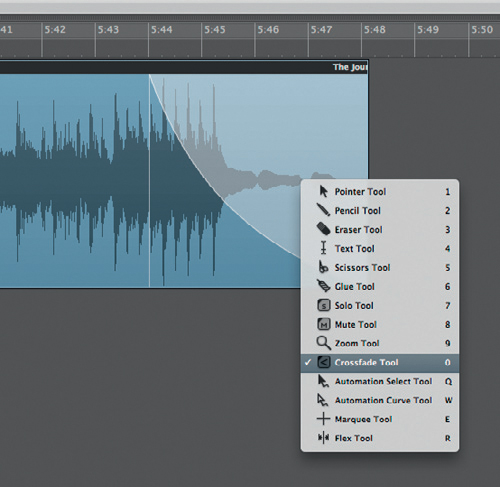
Figure 9.8 For longer fade-outs, you’ll need to render the file with effects, and then create the fade using either Logic’s region fade tool (as illustrated) or the Sample Editor’s fade.
Once the tracks have been processed and edited correctly, you can begin to create the final exported 16-bit masters ready to be burned, or indeed, you could burn the files directly from Logic. The Bounce dialog window again comes into action – either to create the final rendered files or provide access to the Burn feature. Given the regions of the exact finished song length, you can use the Region menu to select “Set Locators by Regions,” and in this way, the cycle length (and therefore the bounce) will be exactly the same length as the region. The Bounce dialog window should specify the creation of 16-bit files, which will necessitate the (final) application of Dither to smooth out any quantizing noise brought about by moving away from 24 bits. Once exported, these files can be dragged straight into iTunes (or other suitable software) ready to be burned.
With burning now supported directly from the Bounce dialog window, you can also burn a CD directly from Logic itself. Again, where the session contains audio files greater than 16-bit resolution, the addition of dithering is essential, which can be selected from the appropriate pop-down menu in the Bounce window. Other pertinent options include setting the write speed (keep this low to avoid any write errors that degrade the audio quality on playback) and writing the disc to a multisession CD. When the “Write as multi-session” option is selected, you’ll be able to add further mixes to the CD at a later point, otherwise Logic will simply burn a single file onto the CD. Although adding sessions at a later point will save the use of CD-Rs, you might experience problems with CD players recognizing songs burned in subsequent sessions.

Figure 9.9 Using the “Set Locators by Regions” feature you can create a new bounce with exactly the same length as that of your edited regions.
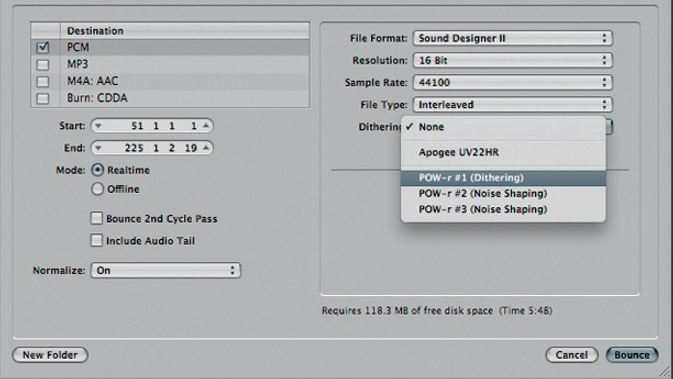
Figure 9.10 The last bounce will need to be dithered down to 16-bit resolution, ready to be burned in another application.

Figure 9.11 Quick and easy CD creation: Logic’s Bounce and Burn feature.
In many ways, the “Bounce and Burn” feature is best viewed as a quick fix for creating audio CDs – especially if you intend to write more than one track to the CD at any given time. In this scenario, it might be, perfectly, legitimate to attempt some rough mastering in the actual project’s file, rather than a separate session – simply insert a Multipressor and some EQ across the main stereo outs and away you go!
Plug-In Focus 2 ![]()
Multipressor and Multiband Compression
Originally developed as part of WaveBurner, Multipressor is Logic’s answer to the big multiband compressors (like the TC M6000 or TC Finalizer, for example) so frequently used in mastering. Unlike conventional single-band compression, a Multiband compressor splits an incoming audio signal into separate frequency bands before applying compression. Separated in this way, a complete mix is far easier to control and gel to form a finished master. In most cases, the greatest amount of compression will be applied to the bottom end of the mix – keeping the bass solid and tight – with the high-end requiring a light and minimal touch.
Multipressor features up to four bands of compression and downward expansion, although, to make things easier, you might just want to use three bands (low, mid, and high, respectively). One of the most important things is to set the right crossover frequencies for the different bands, as this can have a big effect on the finished compression achieved. To set the crossover point, try moving the vertical borders on the top of the interface’s window – you could also use the Spectrum Analyzer (part of the Multimeter plug-in) to visually analyze the track’s constituent components, as well as the band solo feature.
Now, work your way through each band, adjusting the relative compression ratios, thresholds, and attack and release settings. On the whole, most compression ratios tend to fall below 3:1, with the most productive results achieved in the area between 1.5:1 and 2:1. Adjust your threshold to achieve the correct amount of gain reduction and dynamic control. Again, mastering is often distinguished by a lightness of touch, with typical amounts of gain reduction rarely exceeding 2–4 dB. Attack and release times change the responsiveness of the compressor – avoid setting the release too fast (the compressor might start to pump) or squashing the transients too much with a fast attack. Finally, rebalance the bands using the Gain Make-up control. If you’ve compressed a band particularly hard, you might need to bring its level up to restore its position back into the mix.

Figure 9.12 The Multipressor allows you to compress your master using a series of different frequency bands.
For a fully professional result that meets the requirements of Red Book standards, you’ll need to use WaveBurner. Preparing for this will simply involve rendering the files (ideally at 24-bit, without dither) ready to be imported into a WaveBurner session – after this, the rest of the mastering process (compression, editing, and so on) can be carried out in WaveBurner’s domain. The advantages offered by WaveBurner stem from the fact that it is designed, from ground-up, as a tool for mastering – Logic, however, is a dedicated production tool. Track crossfades, for example, can be difficult to create in Logic – this is not the case in WaveBurner. Additionally, with support for CD-Text, UPC/EAN codes, and index marks, WaveBurner is one of the most complete Red Book compliant applications available for the Mac.
After creating a New session (File > New), raw master files can be inserted in WaveBurner through the Region > Add Audio File menu, or by dragging the audio file from Finder. WaveBurner’s screen is divided into four main areas, the most important being the Wave View and Overview areas (toward the top of the screen) that provide a graphic representation of the CD and the various regions that comprise it. The Region list, toward the bottom right-hand corner of the screen, lists the series of regions (or audio files) used in your session – a song, for example, could be constructed from several regions stuck together. The Track list, adjacent to the Region list, lists the Song marker used to break up the CD – more important, these can be completely arbitrarily placed and aren’t necessarily tied to the regions.

Figure 9.13 The WaveBurner interface. (1) Overview – presents a complete overview of all the regions currently used in your WaveBurner session. (2) Wave View area – gives a more detailed presentation of the regions, also where you can perform the various editing tasks (fades, trimming, and so on) in WaveBurner. (3) Regions List – a list of audio files used in your session. (4) Track List tab – changes the pane to show the order and spacing of regions in the playlist and forms the structure of your CD. (5) Plug-ins list – displays the currently configured plug-ins used for the selected region, or the “global” plug-in inserted across the mix outputs. (6) The Inspector – allows you to tailor the audio and glean information about your files. In addition, there are tabs to add Mastering Notes and CD-Text.
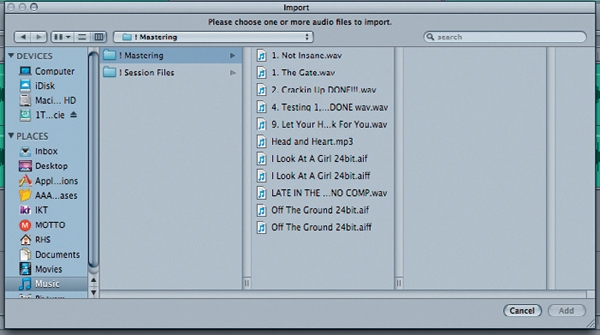
Figure 9.14 Importing new audio files that are ready for mastering.
Audio processing is carried out in the Region and Mix plug-ins list. These work in much the same way as the channel and the master inserts did in the explanation of mastering in Logic. So, for example, the Region plug-ins can be used to process audio files imported into WaveBurner on a song-by-song basis, whereas the Mix plug-ins are applied to the entire program output – in other words, all the tracks. Although the Mix plug-ins can be useful for processing en masse, they are best used for metering and audio analysis. WaveBurner includes the full set of Logic plug-ins, as well as support for third-party audio units.
With WaveBurner’s specific focus on mastering, the editing tools work more quickly and more effectively than Logic’s Sample Editor. Changing start and end points, for example, results in WaveBurner, intelligently, shuffling the other tracks in line with your edits. Fades can be quickly addressed by adjusting the nodes at either end of the region, with options to change the fade curve. More important, unlike trying to master in Logic Pro, these fades are carried out after the Region plug-ins, ensuring a consistent tone irrespective of the fades. Dragging regions over one another creates a crossfade – either to iron out edit points in the two track masters or to create smooth transitions between different tracks.
Plug-In Focus 3 ![]()
Although Multipressor does a good job of bringing the overall dynamic range of your track more in-line with a commercial CD, it’s still possible that your tracks will sound at least 4–6 dB quieter than a professional release. This is because fast transients (often from slightly louder drum hits) have slipped through the Multipressor’s “net” and are still dictating the overall peak level of the track – even though the average level is somewhat below this. Professional mastering engineers will, therefore, make use of a fast-acting digital limiter (sometimes known as a Brickwall Limiter) to catch these peaks and reduce them. With the peaks reduced, the overall track level can be lifted to match the loud output currently favored in mastering.
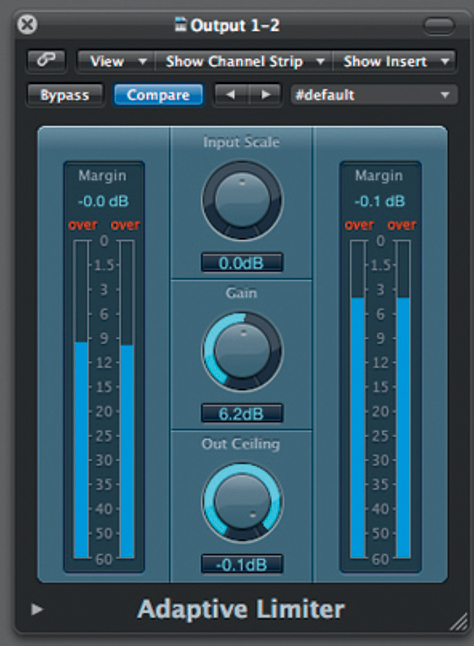
Figure 9.15 The limiter plug-in provides that extra sense of loudness, although you need to be careful on how hard you push this addictive processor.
Logic and WaveBurner’s Limiter, both, present a basic set of controls that should allow you to squash transients in no time. The main parameter, gain, pushes the overall mix harder toward 0 dB – where loud signals would then conventionally distort logic outputs, the Limiter kicks-in and applies gain reduction (indicated in the top meter) to stop this from happening. In most cases, especially those that have already been through the Multipressor, you’ll only need to apply about 3–4 dB of gain, although you will need to listen carefully for any unwanted audio anomalies, especially distortion.
9.9 Dithering, Bouncing, and Burning
By keeping your session masters in a high resolution, you will ensure the best possible signal integrity throughout the entire mastering process. Even so, the reduction to 16-bit resolution and the application of dither are always inevitable. For such a vital process, however, it is easy to miss when and how WaveBurner applies dither. Technically, the controls for dither are actually part of the Bounce preferences (WaveBurner > Preferences > Bounce) – an option whereby WaveBurner creates finished files for the songs you’ve created (just like Logic’s bounce). Bounces can be performed region by region (File > Bounce Region), or if the CD track is made up of multiple regions you can employ the Bounce CD Track feature by selecting the track in the CD Track list and then selecting File > Bounce CD Track. Additionally you are also able to bounce the Mix in whatever audio file format you choose by selecting File > Bounce Mix. Or you can create a bounce of the entire CD as one contiguous “image” file (File > Bounce Project). Rendering the files isn’t essential unless your computer’s under too much strain with its DSP to perform a burn, or because you want to move the files (with effects printed into the mix) into another application.
Plug-In Focus 4 ![]()
Besides the three big mastering tools (EQ, multiband compression, and limiting), both WaveBurner and Logic also feature other plug-ins suitable for track sweetening. Stereo Spread, an effect often found on hardware mastering processors like TC Electronics’ Finalizer, offers the ability to extend the width of a stereo signal – say, for example, the mix had been made slightly too mono. Unlike certain other Stereo Spreaders, Logic’s mix widener avoids the use of phase in achieving extra width – instead, it uses a frequency distribution system to pan alternating frequencies to the left- and right-hand speaker, respectively. By using this frequency distribution method, Stereo Spread avoids the phase problems often associated when a width enhancer is put back into mono. In truth, its effectiveness is somewhat limited, and it only works best with material possessing little or no stereo information.
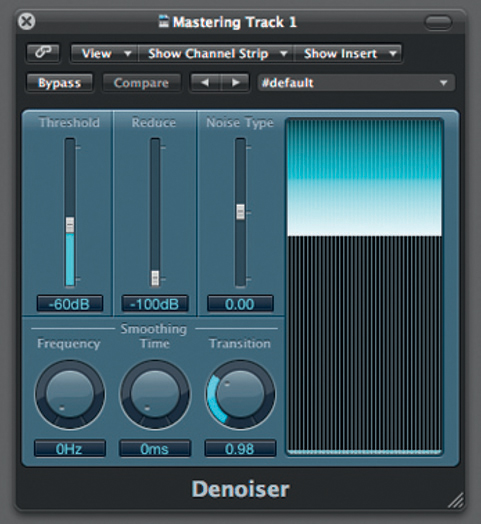
Figure 9.16 Although they have little everyday use, Logic and WaveBurner’s other mastering plug-ins can be useful solutions to a range of mastering problems.
Denoiser uses some clever trickery with FFT filtering to produce a cleaner audio signal in situations where the master possesses a large amount of unwanted noise. Like a conventional noise gate, Denoiser needs its Threshold set carefully to make the best use of the effect – try locating a quiet section of the master, with the noise present, and set the Threshold just above this. Reduction defines the amount of Denoising taking place, although if pushed too hard the Denoising can sound almost as distracting as the noise itself! The Noise Type fader seems a little strange at first, but it does make sense – in the center position, the fader is sensitive to noise across the entire audio spectrum, toward the top its bias is toward darker noise, and to the bottom it is more sensitive to high-frequency noise.

Figure 9.17 Creating fades in WaveBurner completely with a variety of fade curves. Drag the small nodes to define the length and shape of the fade.

Figure 9.18 Crossfades are made by dragging regions into each other’s timeline.
What isn’t immediately obvious is that the Bounce preferences also dictate how WaveBurner burns audio to a CD – particularly with respect to the application of Dither. Therefore, as long as the Bounce preference is set to dither, WaveBurner will automatically dither your files as part of the burn – without specifying the need to burn. In the rare case that you are importing files already processed and dithered, you’ll need to remember to return to the preferences and turn the dithering off.
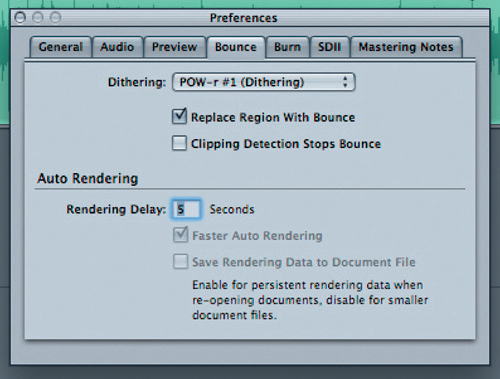
Figure 9.19 The Bounce preferences contain WaveBurner’s dithering options – applied either to a bounce or to the final burn.
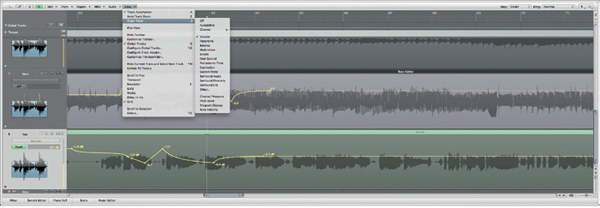
Figure 9.20 Use the Bounce Project icon to render WaveBurner’s output as an audio file, or to create a contiguous image file of the final CD.
By pressing the “Create Disc icon,” you can initiate the burn – although this is only the beginning of the process of learning mastering. For something so apparently simple (how difficult can two tracks and a multiband compressor be?), the real art of mastering professional CDs will take a lifetime to master. Ultimately, the art of mastering is a surprising blend of a gut instinct for what sounds right (in other words, the mastering engineers “ears”), alongside a complete understanding of the technical criteria of manufacturing an audio product. At least with Logic and WaveBurner you have some powerful tools in hand, and the opportunity to present your music in the best possible way.
Walkthrough 1 ![]()
Editing and Assembling a CD in WaveBurner
Step 1:
Start a new project in WaveBurner (File > New) and import your required 24-bit session masters (File > Import Audio File). Try resizing the three areas of WaveBurner’s interface (Overview, Wave area, and Regions lists) to best suit your needs – here, we’ve selected a small overview and Regions list, alongside a large, clear wave area for editing. With the songs imported, you’ll probably need to perform some basic edits before going any further. To do this, click on the region you want to edit (from the overview) and click and drag either the start or the end point to resize the region. Leave some duration of silence at the start to allow for CD demuting.
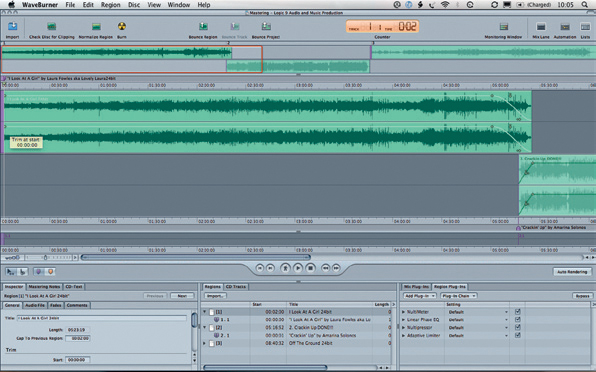
Figure 9.21
Step 2:
Add fades onto either the beginning or the end of the track by dragging the small node at either end of the region. You can change the curve of the fade, using the other two nodes that appear – sometimes the linear fade can be a little too obvious to the ears, whereas curves can be more gentle or extreme depending on the material you’re playing with. Another important thing to look at are the gaps and pacing between the tracks, as illustrated by the purple-shaded “pause time” area. Try slipping the next region backward or forward to match the required pace of transition – this is an important way of setting the feel of the album.
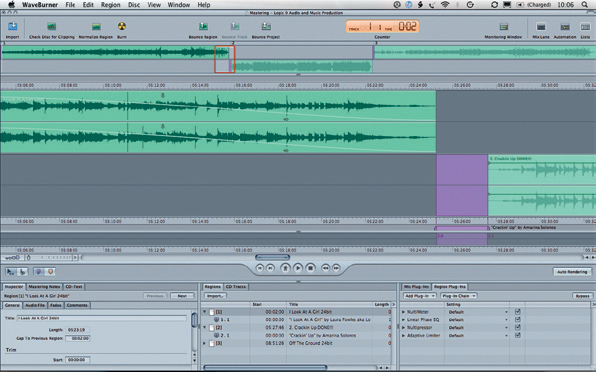
Figure 9.22
Step 3:
Where a region is dragged back beyond the shaded pause area, a crossfade can be created between the two tracks. As with the fade-in and fade-out, the curve of this can be adjusted to get the smoothest, most musical transition between the two tracks. WaveBurner will automatically place the Song marker halfway between this transition – if you want it placed elsewhere, drag the small purple marker on the top of the wave area back to the appropriate point. In addition to song markers, you can place index points – simply change the marker tool (bottom right) from purple to orange.

Figure 9.23
Walkthrough 2 ![]()
Audio Mastering and CD Burning

Figure 9.24
Step 1:
With the structure of the CD defined, you can turn your attention to the sound in an attempt to get a “loud” consistent tone throughout. To perform this, some informative metering is essential so that you can hear and see detailed qualities of the track you’re working with. In the Mix plug-ins list, insert an instance of WaveBurner’s Multimeter and the Level Meter – this should give you a good overview of the timbre and the overall level of your CD. Try importing a commercially mastered track (similar to the CD you are working with) to get some reference to how things should look and sound.
Step 2:
Now turn your attention to the sound of the individual regions. Select a region from the Region list, click on the Region Plug-Ins tab, and insert the appropriate processing to achieve the desired sound. In most cases, a combination of the Linear-Phase EQ, Multipressor, and Limiter (in that order) should pull the mix up to the point where it sounds “loud and proud.” Check the results against the other tracks so that you achieve a consistent tone. Most important, avoid excessive clipping or distortion, which you can identify through careful listening, or (from a technical perspective) using the Disc > Check Disc for Clipping menu option.

Figure 9.25
Step 3:
If everything’s sounding sweet, you’re ready to do the final preparation for the burn. If your source files are 24-bit, you’ll need to check the dithering status of WaveBurner. To check this, go to WaveBurner’s preferences and select the Bounce tab. Now pick a dithering option from the pull-down menu – POW-r # 1, 2, or 3. Dithering is applied either when you Bounce files in WaveBurner, or as it creates the final burn. To set the burn in action, click on the Create Disc icon and insert a blank CD-R into your CD writer. To ensure a minimal error rate, use the lower burning speeds.
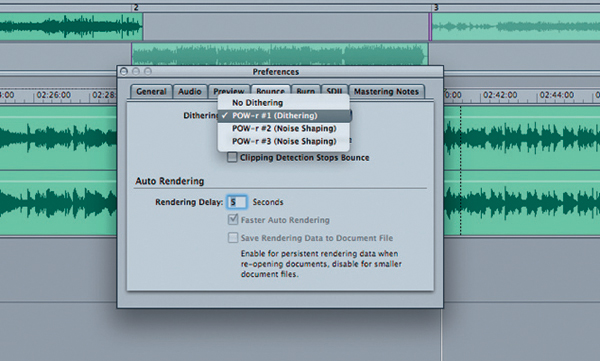
Figure 9.26
Knowledgebase 3 ![]()
Until Logic Studio 9, WaveBurner was unable to write Disc Description Protocol (DDP) images. This protocol, developed by Doug Cardon and Associates, is a way of describing the whole audio CD as simply data. Until now, only top flight mastering applications allowed for this. The introduction of this feature within Logic’s suite of applications finally means that the whole production can be handled within your Mac.
DDP images can be written to a CDR-R, or a DVD-r, dependent on file size, but can be placed in a folder for sending over the Internet. DDP offers a degree of quality control not always available from a simple burned audio CD. As the DDP is essentially data, it follows high-standard error correction, and as such it is unlikely to work if it is in the slightest bit corrupted. However, if it works, it will be perfect, and this ensures that the quality of your master reaches the pressing plant in perfect condition.
To write a DDP image from WaveBurner, simply go to File > Save DDP Image… This will create a few files, so you may wish to create a folder for the image. Do ensure that you take the time to complete the Mastering Notes section in full before writing your image.
Knowledgebase 4 ![]()
POW-r comes with three options within Logic. One is labeled “Dithering” which employs a noise-shaping curve to reduce noise. The remaining settings offer two types of noise shaping. The Logic Manual describes the first noise-shaping algorithm, which can “extend the dynamic range by 5–10 dB.” The second noise-shaping algorithm is intended for work with speech as it can “extend the dynamic range by 20 dB within the 2–4 kHz range – the range the human ear is most sensitive to” (Apple Logic Manual). These noise-shaping curves have been developed to be sympathetic to the human ear and draw upon considerable research beginning with Fletcher and Munson’s Equal Loudness Contours (More information on Equal Loudness Contours can be found in Rumsey, F. & McCormick, T. (2002) Sound and Recording, An Introduction. Focal Press).
